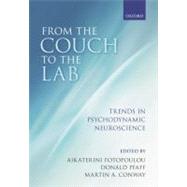
Note: Supplemental materials are not guaranteed with Rental or Used book purchases.
Purchase Benefits
What is included with this book?
| Contributors | p. ix |
| Abbreviations | p. xi |
| Introduction | |
| Background, ethos, and content | p. 3 |
| The history and progress of neuropsychoanalysis | p. 12 |
| Towards a psychodynamic neuroscience | p. 25 |
| Drives and motivation | |
| Freudian drive theory today | p. 49 |
| Generalized brain arousal mechanisms and other biological, environmental, and psychological mechanisms that contribute to libido | p. 64 |
| Theoretical challenges in the conceptualization of motivation in neuroscience: Implications for the bridging of neuroscience and psychoanalysis | p. 85 |
| Drive and structure: Reconsidering drive theory within a formalized conception of mental processes | p. 109 |
| Emotion | |
| Freudian affect theory today | p. 133 |
| A meditation on the affective neuroscientific view of human and animalian MindBrains | p. 145 |
| Emotions in the psychoanalytic theory | p. 176 |
| Emotion and delusion: Seeking common ground between neuroscience and the psychotherapies | p. 186 |
| Conscious and unconscious processes | |
| The Freudian unconscious today | p. 209 |
| Free-energy and Freud: An update | p. 219 |
| Psychoanalysis, representation, and neuroscience: The Freudian unconscious and the Bayesian brain | p. 230 |
| What is the unconscious? A novel taxonomy of psychoanalytic, psychological, neuroscientific, and philosophical concepts | p. 266 |
| The lexicographer's nightmare | p. 282 |
| Unconscious fantasy and schema: A comparison of concepts | p. 293 |
| Mechanisms of cognitive control | |
| On unconscious inhibition: Instantiating repression in the brain | p. 307 |
| From dynamic to behavioural lesions: The relative merits and caveats of elucidating psychoanalysis with brain imaging | p. 338 |
| From Freud to neuroimaging: Hypnosis as a common thread | p. 356 |
| Great escapes: Psychological forms of amnesia | p. 373 |
| Memory and the self | p. 386 |
| The development of the self: embodied and social cognition | |
| The multidimensional construct of mentalization and its relevance to understanding borderline personality disorder | p. 405 |
| Sense of 'sameness' as foundation of infants' embodied subjectivity and intersubjectivity | p. 427 |
| Identification: The concept and the phenomenon | p. 439 |
| The sense of agency in health and disease: The contribution of cognitive neuroscience in understanding self-consciousness | p. 455 |
| Author Index | p. 467 |
| Subject Index | p. 477 |
| Table of Contents provided by Ingram. All Rights Reserved. |
The New copy of this book will include any supplemental materials advertised. Please check the title of the book to determine if it should include any access cards, study guides, lab manuals, CDs, etc.
The Used, Rental and eBook copies of this book are not guaranteed to include any supplemental materials. Typically, only the book itself is included. This is true even if the title states it includes any access cards, study guides, lab manuals, CDs, etc.